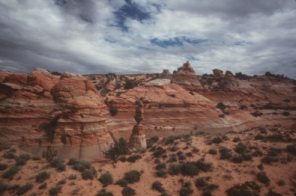Sedimentary RocksSedimentary rocks are those formed from the compaction and cementation of fragments of pre-existing rocks called clasts, or plant and animals remains. The exogenic processes of weathering and erosion create the raw materials for sedimentary rocks. Earth material is loosened and moved from higher to lower elevations where it is deposited as transportation agents like water, wind or gravity lose their energy to move sediment. Streams and rivers transport sediment to lakes or oceans, or deposits it on nearby floodplains where it accumulates. On land, clastic sediments consist mainly of large boulders, cobbles, gravel, sand, and silt. On the continental shelves at the margin of continents, marine sediment is largely sand, silt, and clay. At the outer shelves and on the ocean floor, clays and chemically precipitated calcium carbonate and the remains of tiny marine animals accumulate.
As layers of sediment accumulate to great thickness, they are compacted and begin to harden into sedimentary rock. Each layer they form is called a bed or stratum, the process by which this occurs is called stratification. The separation between each bed is called a bedding plane and signifies a cessation of deposition at that location for a period of time. Beds can vary horizontally due to differences in the energy conditions and distance from the origin of the sediments. For instance, a bed may change from a conglomerate of cemented gravel, to compacted silt called siltstone, and finally to shale which is cemented clay, indicating the decreasing power of water to transport these different size materials from away from their source. Generally speaking, if the layers have not been disturbed, the oldest layers are at the bottom. Often there is a cementing agent that holds the materials together. Because many sedimentary rocks are formed from fragments of rocks, they are weaker than igneous or metamorphic rocks. |
 Figure 14.15 Sandstone beds are easily seen in the cliffs of Paria-Vermillion
Canyon, Arizona (Courtesy U.S. Bureau of Land Management)
Figure 14.15 Sandstone beds are easily seen in the cliffs of Paria-Vermillion
Canyon, Arizona (Courtesy U.S. Bureau of Land Management)